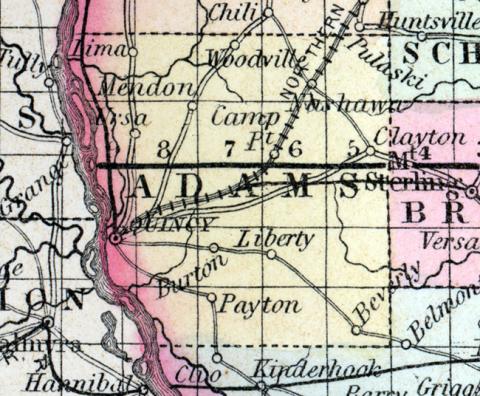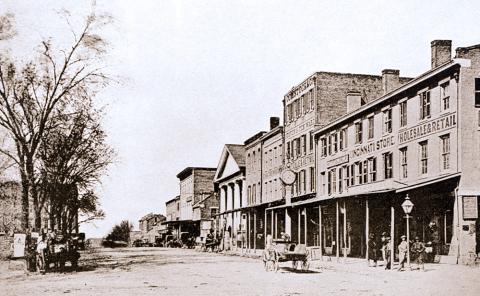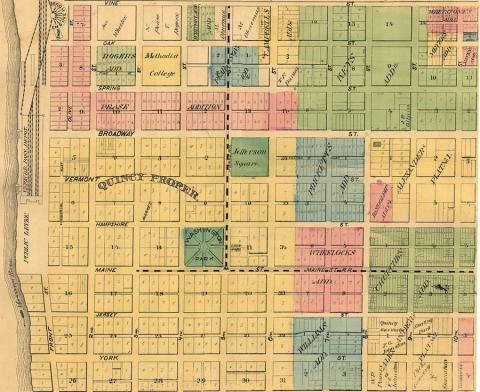QUINCY, p-v., capital of Adams co., Ill., 101 s. Springfield, 884 W. Situated on a bluff, on the E. side of Mississippi r., 125 ins. above the mouth of Illinois r., by water, and contains a court house, which cost $20,000, 4 churches—1 Congregationalist, 1 Episcopal, 1 Methodist, and 1 Baptist—25 stores, a United States land office, a large steam flouring and saw m., a carding machine, about 200 dwellings, and 1,500 inhabitants. The court house stands on a fine public square. There are about 300 steamboat arrivals annually; and pork is annually exported to the amount of $100,000. (Haskell's Complete Descriptive and Statistical Gazetteer of the the United States...,1843)
QUINCY, c. h., p v., seat of justice of Adams co., Ill., 104 ms. W. of Springfield; from W. 884 ms. Watered by Mississippi river. Pop. 6,911. (Fanning's, 1853)
QUINCY, Is a flourishing city, capital of Adams county, beautifully situated on the Mississippi river, 160 miles above St. Louis, 110 north of west from Springfield, and 268 south-west from Chicago, at the western terminus of the line of railroad connecting it with the latter place. It is the central market for a country unsurpassed for fertility and productiveness, still enjoying extraordinary facilities for manufacturing, mechanical and mercantile pursuits. Abundance of coal is found in close proximity to it, and an unlimited supply of pine and other lumber easily attainable from the upper waters of the Mississippi, arrivals of which are of daily occurrence. Immense forests of walnut, oak, maple and other hard wood, cover the islands of the river at this point and on the opposite shore, with every facility for its ready manufacture and use. The bluffs are of limestone, admirably adapted for building purposes, and lime and brick are manufactured on an extensive scale. The beauty of the location, the healthiness of the climate, and the cheapness of living have had a tendency to attract to this point large numbers of mechanics and men of once limited means, who are now among the most wealthy of her citizens.
Quincy was selected as a town site in 1821, by the Hon. John Wood, now Lieutenant Governor of the state, who, in the fall of 1824, applied for and obtained an act for the establishment of Adams county, the limits being the same as at present exists. During the years from 1825 to 1834, the city grew but slowly. In the latter year an act of incorporation was granted, at which time it changed for the better, and has since advanced with a rapidity and permanence which has marked but few of our western cities. In 1836 the population amounted to 700, and in 1887 it had increased to 1,663. In the same year a large number of fine buildings were erected, among which were the Quincy House and the court house. In 1841 the number of inhabitants was 2,686, and the sales of produce were 275,000 bushels of wheat, 95,000 bushels corn, 60,000 bushels of oats, 12,000 packed hogs, and the number of steamboat arrivals 1,000. Coming still further down to the year 1849, the population had increased to 5,500, and the city contained 126 stores, hotels and public buildings. The annual increase in population from 1849 to 1857 has been about 1,600. In 1868, Quincy was made a port of entry under the collection of New Orleans, and is the only point on the Mississippi where steamers of heavy draft can land at low stages of water. On the opening of the Chicago and Quincy railroad to this place, a new impetus was given to trade and commerce, and a large section of country made tributary, from many points of which large quantities of grain and produce are annually brought here for shipment.
Several lines of railroad are in contemplation, and will soon be built, with a view to add still more to the commercial interests of the city, the most important of which is the Quincy and Toledo line. The amount contributed towards this road by the citizens of Quincy and the towns through which it will pass, now reaches $300,000, two-thirds of which was subscribed in this city. $150,000 has also been subscribed towards the road uniting Quincy with various important points in Missouri, by way of the Hannibal and St. Joseph Railroad, connecting at Palmyra. The manufacturing interests of Quincy are of no inconsiderable amount, comprising six large flouring mills, viz.: the Castle, City, Centre, Eagle, Star and the Alto, capable of grinding 660,000 bushels of wheat; two corn and feed mills, grinding 135,000 bushels, and four saw mills in the city and its immediate vicinity, producing 19,600,000 feet of lumber annually. Four machine shops have constant business, making sales throughout Illinois, Missouri and Iowa, the value of whose manufactures amounts to $195,000. Quincy contains the largest stove foundry on the Mississippi, employing some 60 hands; besides this there are four other large foundries, all doing a very heavy business. In addition to the above, eight firms, who combine manufacturing and selling stoves and tinware, do a business of $185,000. Two firms engaged in copper and sheet iron working turn out $25,000 worth of work annually; four furniture factories, employing 176 hands, produce $207,000 worth annually; nine wagon factories, which in the last ten months of 1857 produced 1,485 wagons, valued at $107,626; one plow factory, making 1,100 plows annually; two carriage factories, producing $83,000 worth annually; an agricultural implement establishment, doing a business of $25,250 per annum; thirteen cooperages or barrel factories, doing a business of $200,000 annually; eight extensive brick yards, employing 119 hands, and producing annually 56,310,000 bricks, worth $160,000; three lime kilns, producing $45,000 annually; two marble working establishments, doing business to the amount of $27,000 annually; a wooden ware factory, turning out manufactured articles to the amount of $15,000 annually; two boiler factories, producing $47,000 worth of work annually; six planing mills, whose business amounts to $126,000 annually; eight distilleries, producing annually $600,000 worth of liquors; five breweries, doing a business of $40,000 annually; two soda water manufactories, doing business to the amount of $35,000 (these are in operation only during the summer months); one vinegar and one rope manufactory; two soap and candle factories; three book binderies; ten saddle and harness factories; fourteen confectionery manufactories, the amount of whose business cannot be correctly ascertained. The packing of provisions is carried on to the extent of about 10,000 barrels annually.
There are here five newspaper offices, having daily and weekly issues, viz: Herald, Whig, Republican, Tribune and Courier; three banks, four good hotels, the principal of which is the Quincy House (see advt), and twenty-one churches. A most excellent literary association is in existence, the library of which contains about 8,000 volumes. The educational advantages of Quincy are good, consisting of one college or seminary (English and German, see advt.), in which are taught all the branches as in a collegiate course, and accessible for males and females; three first class public schools, and many others of a private character. In the three public schools are taught all the principal branches of higher English literature. The teachers are paid by the city, and the books furnished to students on application, free of cost
As a city, Quincy stands prominent among the monuments.of the indomitable energy and will of those who have made the state what it is, one of the proudest in the Union. Austin Brooks, Postmaster. (Hawes' Illinois State Gazetteer..., 1859)



